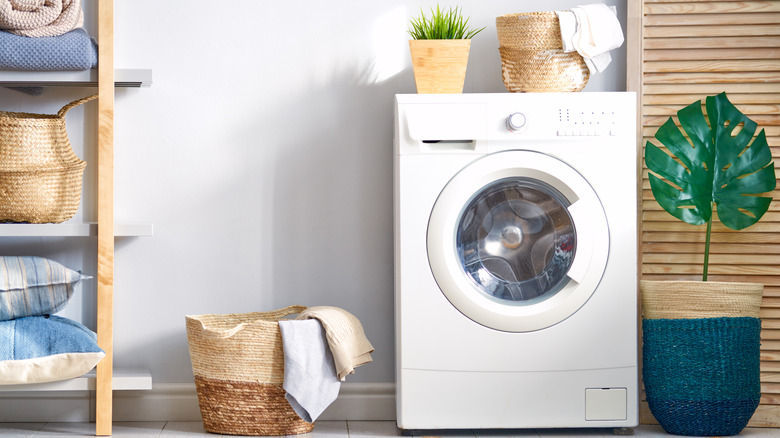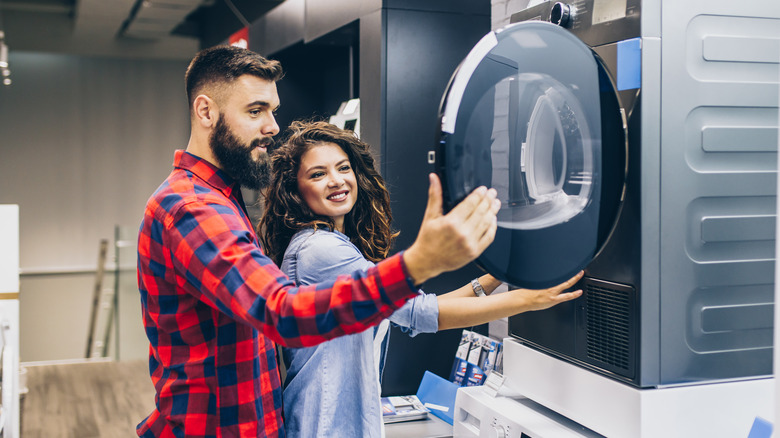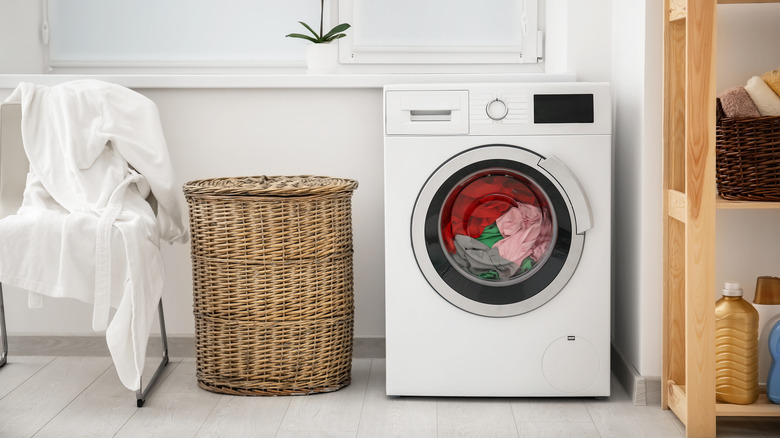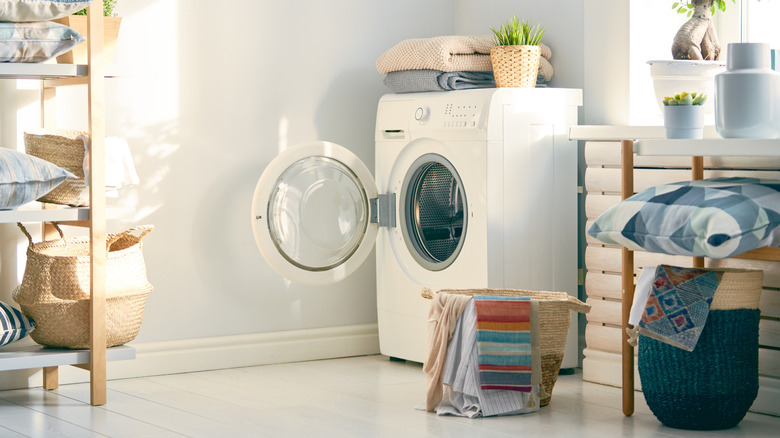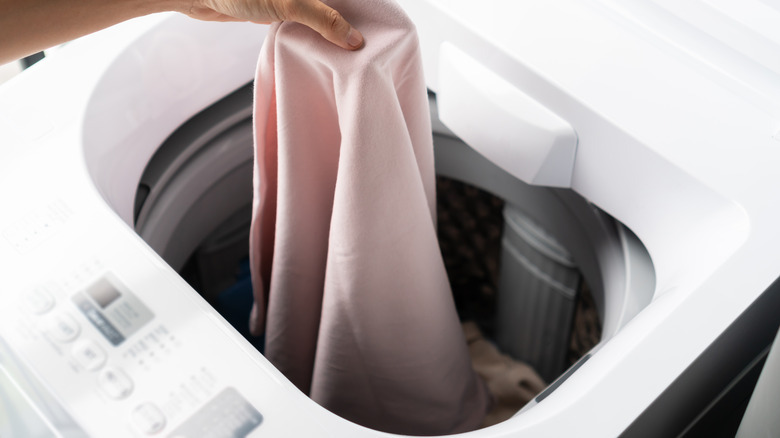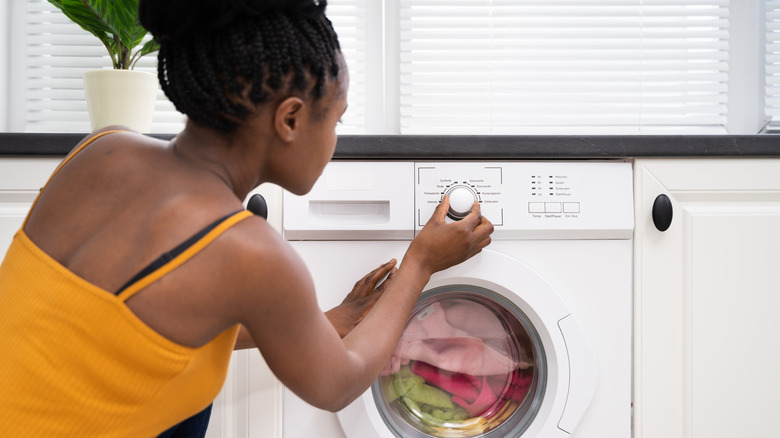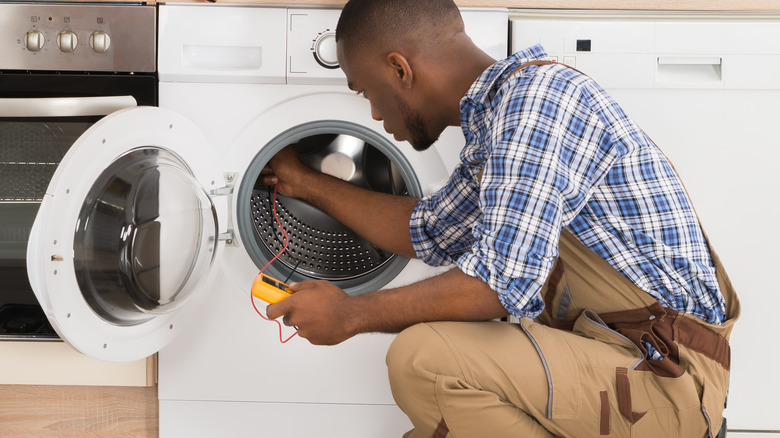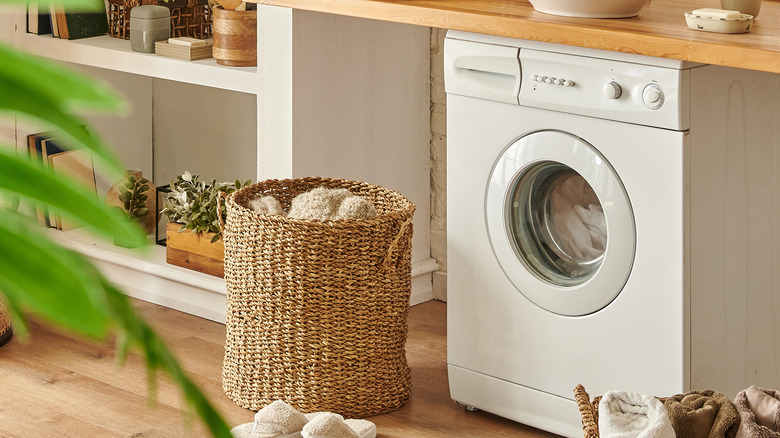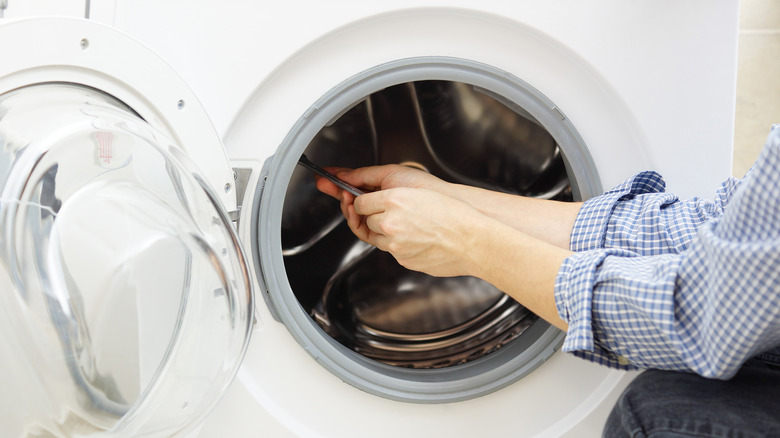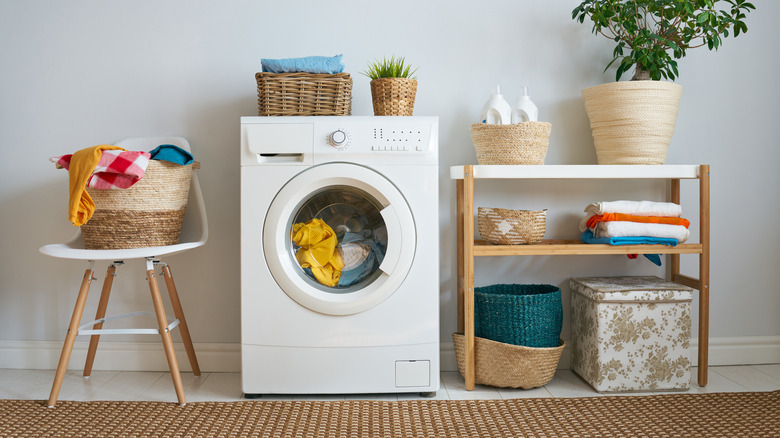Fully-Automatic Vs. Semi-Automatic Washing Machines: What's The Difference?
We may receive a commission on purchases made from links.
Choosing a washing machine is a big decision that should be carefully thought out. It's a pricey purchase, and with the average washing machine lasting up to 11 years, according to How Stuff Works, it's a long-term one, too. Not only do you have to choose from among a dizzying number of brands, colors, sizes, and additional bells and whistles, the actual type of washing machine is a major part of the decision process. That is, do you want a fully automatic washing machine or a semi-automatic one?
Fully automatic washing machines are just that — fully automated. Per Home Questions Answered, a fully automatic washing machine performs all steps of the wash cycle with just one click of a button, including washing, agitating, rinsing, and spinning. Semi-automatic washing machines, on the other hand, typically have two separate tubs — an initial washing tub and a separate drying tub that spins the clothes, according to Ariel. While most modern washing machines are fully automatic, there are pros and cons to both types of machines. Read on to learn the differences, benefits, drawbacks, and more of fully automatic and semi-automatic washing machines.
How does the appearance differ?
There is a clear visual difference in the design of a fully automatic washing machine versus a semi-automatic one. Fully automatic washing machines only have one washing barrel, whereas semi-automatic washing machines usually have two washing tubs. Furthermore, semi-automatic washing machines can only be top-loading due to the nature of their functionality. Fully automatic washing machines, on the other hand, can be top or front loading, as per iFFalcon.
That being said, both machines come in a wide variety of sizes, colors, etc., and can look virtually indistinguishable from one another, save for the mechanical differences. While semi-automatic washing machines have a reputation for being a little clunky and cheap-looking, modern machines can look just as sleek and high-tech as big-budget, fully automatic machines.
What are the differences in cost?
A major difference between semi-automatic and fully automatic washing machines is the cost of purchase and operation. Semi-automatic washing machines are generally much less costly than fully automatic washing machines, and they require less water, per Ironing Zone.
Semi-automatic machines are also sold in a compact, mini version that is perfect for apartments without washer-dryer hookups (more on that later). As such, they can be found as low as around $180, such as this one from Amazon. Other models can run anywhere from around $190 (found here) to $220 (found here).
Fully automatic washing machines, though, are drastically more expensive, running anywhere from nearly $700, like this one from Home Depot, to up to $3,200, like this LG model also found at Home Depot. They also use more water, which adds to your monthly bills. That being said, you are paying for longevity, quality, ease of use, and, in most cases, a warranty.
Pros and cons of fully automatic washing machines
Fully automatic washing machines are the most popular of the two types, with most modern washing machines functioning in this way. For one, they are much easier to use than semi-automatic washing machines, as you only have to add laundry detergent, fabric softener, and maybe bleach, select a setting, and press start. These days, fully automatic machines often include smart technology that can determine the best wash cycle and temperature for your clothes as well.
Aside from washing your laundry faster, the machines can also be found in both front load and top load styles, as per iFFalcon. Top load styles are convenient in that you don't have to bend down to do laundry while front load machines allow you to stack a dryer or other laundry-related equipment on top.
That being said, fully automatic washing machines are significantly more expensive, and even though it's a roughly once-a-decade purchase, this doesn't take away the initial cost. They also use much more water, which runs up your water bill.
Pros and cons of semi-automatic washing machines
Semi-automatic washing machines are less popular as they require more labor than a fully automated machine. Using a semi-automatic machine involves manually filling the tub with water, adding your clothes and detergent, running the first cycle, draining the machine, and then moving the contents to the spinning tub, explains Ironing Zone. There also isn't an agitator, which means stains may not come out in the wash cycle.
That may sound like a lot of work, and it is, at least compared to fully automatic washing machines. That being said, this type of machine is not without its benefits. For one, it consumes a lot less water since you control how much you use. For comparison, Bloomberg points out that an average fully automatic machine uses 20 gallons of water to clean just 1 tablespoon of dirt.
Another major pro of semi-automatic washing machines is that they often come in portable sizes, which can easily fit in a bathroom or other small space. This is perfect for renters without in-unit laundry or those who don't want to drain their bank account by purchasing a fully automatic washing machine.
What are the differences in energy use?
Regardless of which laundry machine you choose, it is not the most environmentally friendly appliance on the market. The best way to do laundry in an eco-conscious manner is handwashing, but this can be time-consuming and labor-intensive, which is unsustainable for most people.
Fully automatic washing machines consume more energy than their semi-automatic counterparts and, consequently, negatively impact the environment. Additionally, National Park Service reports that most residential fully automatic washing machines average 41 gallons of water per wash cycle. Semi-automatic washing machines use as much water as you put in, and nothing more.
That being said, most modern fully automatic washing machines are more eco and energy conscious, though they still emit 179 million metric tons of carbon dioxide a year across the U.S., as per The New York Times. There are steps you can take to reduce your carbon footprint and energy consumption, such as opting for a more high-tech machine and running cold-water cycles as much as possible, explains The Washington Post.
Durability and maintenance
Durability is a major consideration when deciding which washing machine to purchase. Modern washing machines can last up to 14 years if you do a load of laundry every day, according to Durability Matters. This averages to about 5,100 loads of laundry overall. With routine care and maintenance, both fully and semi-automatic machines should last a long time. However, semi-automatic machines are usually cheaper and made with lower-quality materials, which could lead to issues down the road.
Fully automatic washing machines do require maintenance to last the full 14 years. Mr. Appliance has a list of routine maintenance tasks you can carry out at home to prevent needing to call a technician, which include using appropriate detergent, replacing the hose every three to five years, potentially installing a drain vent, leaving the lid open to dry out between uses, and regular cleaning of both the tub and lint filter. Kingstree Plumbing also recommends running a service wash every few months. Other maintenance duties include replacing the anode rod in the hot water heater every three to six years and running checks on the sump pumps.
How do they differ in real estate value?
Washing machines are one of the most heralded pieces of technology for modern convenience, and as such, add a lot of value to your home when selling. Home buying is already a hassle, and not having to move and install a heavy piece of machinery is certainly a convenience worth paying for. In fact, The New York Times states that adding a washer and dryer to your apartment can help raise the listing price up to 5 percent higher.
High-efficiency, fully automatic washing machines are a big hit with potential buyers, according to Apartment Therapy. They particularly recommend any machine approved by the Energy Star program. Unfortunately, semi-automatic washing machines are often viewed as inconvenient, and since most models are portable, they won't add much value to your home.
Installation difficulty
Installing a washing machine is the main hassle that comes after purchasing the equipment. That being said, if you have a washer-dryer hookup already installed, it's much easier, and can even be done without professional help, according to Home Depot. To install a fully automatic washing machine yourself, you first have to uninstall and get rid of the old unit. Then, connect the water supply hoses from the back of the new machine to the water hookups in the wall. Next, set up the drain hose. In already installed plumbing, there will be a standpipe. You can feed this into a nearby sink. The final step is to level the unit.
Semi-automatic installation is similar, but people often choose to connect the machine to a sink to more easily fill the basin. To install a semi-automatic washing machine, Samsung says to take the drain hose and hook it up to the machine's drain outlet using a joint ring. Then, insert the inlet hose into the faucet you've chosen. This process is a little easier than installing a fully automatic washing machine.
When to choose fully automatic over semi-automatic
Choosing a washing machine is an entirely personal decision, but certain individuals should go for a fully automatic machine over a semi-automatic one. For example, Ironing Zone does not recommend semi-automatic washing machines for elderly people who may not be able to carry out the manual labor required for operating the machine. Similarly, anyone with physical, mental, or lifestyle situations that prevent them from being able to consistently perform this added labor should opt for the convenience of a fully automatic one.
There are also situations in which a semi-automatic washing machine makes more sense. For people worried about high water and electricity bills, semi-automatic washing machines are the way to go. They are also slightly more environmentally friendly. Lastly, they're a great choice for people who don't have a washer-dryer hookup in their home or apartment and who don't want to consistently lug their laundry to a laundromat. Again, the decision ultimately comes down to your lifestyle, personal preference, and how much you're willing to spend on convenience.
